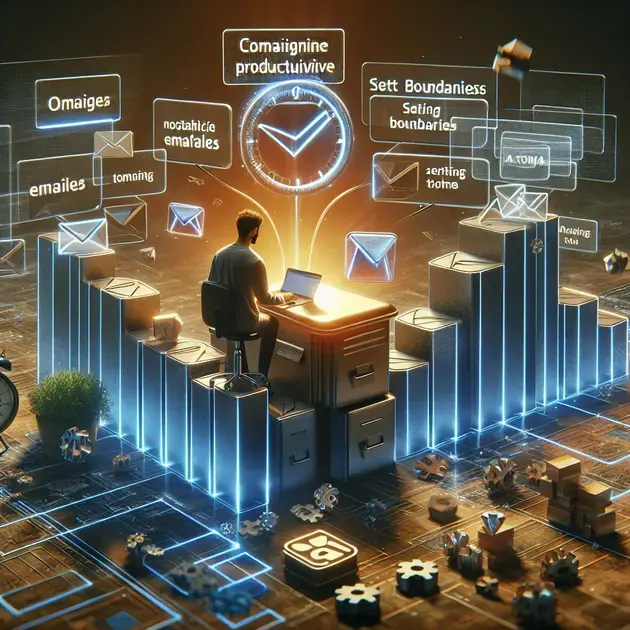When it comes to maximizing productivity, managing emails effectively is crucial in today’s fast-paced digital world. With the average office worker receiving over 120 emails per day, it’s easy to feel overwhelmed and unproductive if your inbox is not well organized.
One effective strategy for managing emails efficiently is to set specific times throughout the day to check and respond to them. By batching your email tasks, you can avoid constant distractions and maintain focus on other important projects.
Effective Email Management Strategies
Managing emails effectively is essential for staying organized and productive. One useful strategy is to set boundaries for better email productivity. By establishing clear guidelines and sticking to them, you can avoid email overload and focus on what truly matters. Here’s a step-by-step guide on how to set boundaries for better email productivity:
1. Define Your Email Checking Schedule
Start by determining how often you need to check your email based on your job role and responsibilities. Use tools like the “Mail Settings” feature in Gmail to schedule specific times for checking and responding to emails. By setting designated time slots for email management, you can reduce distractions and improve focus on other tasks.
2. Implement Email Filters and Labels
Organize your inbox by creating filters and labels to automatically categorize incoming emails. Platforms like Outlook and Thunderbird offer customizable filtering options to sort emails based on sender, subject, or keywords. By streamlining your inbox, you can easily prioritize important messages and avoid getting overwhelmed by irrelevant ones.
3. Set Clear Communication Expectations
Communicate your preferred email response times to colleagues and clients to manage their expectations effectively. Use email signature tools like WiseStamp to create personalized signatures that include your availability and response time. By setting clear boundaries on when and how you respond to emails, you can establish a more efficient communication flow.
4. Use Email Management Apps
Explore email management apps like Boomerang, SaneBox, or Mailbird to optimize your email workflow. These tools offer features such as email scheduling, follow-up reminders, and inbox prioritization to help you stay on top of your messages. By leveraging the capabilities of email management apps, you can enhance your productivity and reduce email-related stress.
5. Regularly Declutter Your Inbox
Take time to declutter your inbox by archiving or deleting old emails that no longer serve a purpose. Utilize the “Archive” feature in Gmail or the “Clean Up” tool in Outlook to remove redundant messages and free up space. By maintaining a clean and organized inbox, you can easily locate important emails and prevent information overload.
Maximizing Focus with Email Batching
Email batching is a productivity technique that involves grouping similar tasks together to streamline workflow and enhance focus. By dedicating specific time blocks for handling emails in batches, you can avoid constant interruptions and improve your concentration. Here’s how to maximize focus with email batching:
1. Schedule Dedicated Email Blocks
Allocate fixed time slots throughout your day for checking and responding to emails. Use time management tools like Trello or Todoist to create a schedule that includes designated email batching periods. By establishing consistent routines for email management, you can reduce multitasking and increase productivity.
2. Prioritize Important Emails
Identify and prioritize critical emails that require immediate attention during each email batching session. Tools like DragApp or Sortd offer kanban-style boards to categorize emails based on urgency and importance. By focusing on essential messages first, you can address crucial tasks efficiently and avoid feeling overwhelmed by a cluttered inbox.
3. Limit Email Notifications
Minimize distractions by turning off email notifications during focused work periods. Adjust your notification settings in email clients like Outlook or Apple Mail to prevent constant pop-ups and alerts. By silencing unnecessary notifications, you can maintain concentration on priority tasks and improve overall work efficiency.
4. Create Standardized Email Templates
Save time and effort by creating standardized email templates for common responses or inquiries. Use productivity tools like TextExpander or Gmail Templates to create reusable email snippets with pre-written content. By streamlining your email communication with templates, you can speed up response times and maintain consistency in your messaging.
5. Reflect and Refine Your Batching Strategy
Regularly evaluate your email batching process to identify areas for improvement. Analyze your email response times, effectiveness, and overall productivity using performance tracking tools like RescueTime or Clockify. By reflecting on your batching habits and making necessary adjustments, you can optimize your focus and achieve better email management results.
Setting Boundaries for Better Email Productivity
In today’s fast-paced work environment, managing email effectively is crucial for productivity. One way to improve email productivity is by setting boundaries. By establishing specific times to check and respond to emails, you can avoid getting constantly distracted and maintain focus on your tasks.
To implement boundaries for better email productivity, start by defining dedicated email time slots throughout your day. This could be in the morning, after lunch, and before the end of your workday. During these times, focus solely on email-related tasks and avoid checking your inbox outside of these designated periods.
Additionally, consider turning off email notifications or setting specific times to receive email alerts. Constant notifications can disrupt your concentration and decrease your overall efficiency. By limiting interruptions, you can create a more focused work environment and prevent email from becoming a constant source of distraction.
Another strategy for setting boundaries with email is to establish clear response expectations. Let your colleagues know when they can expect to hear back from you and communicate your availability for meetings or calls. By managing others’ expectations, you can reduce the pressure to respond immediately and allocate time for thoughtful, comprehensive replies.
Overall, by setting boundaries for better email productivity, you can enhance your focus, reduce distractions, and optimize your workflow for improved efficiency.
Maximizing Focus with Email Batching
Email batching is a technique that involves grouping similar tasks together to maximize efficiency and focus. When it comes to email productivity, batching can be a game-changer. By dedicating specific blocks of time to process and respond to emails, you can avoid constant context switching and maintain a higher level of focus throughout your workday.
To start email batching, allocate predetermined time slots in your schedule specifically for handling emails. For example, you could set aside 30 minutes in the morning, another 30 minutes after lunch, and a final session before wrapping up your workday. During these dedicated periods, focus solely on your inbox and avoid multitasking with other work responsibilities.
When batching emails, prioritize tasks based on urgency and importance. Address time-sensitive messages first, followed by non-urgent correspondence. By categorizing emails and tackling them in batches, you can streamline your workflow and prevent inbox overload.
Another tip for maximizing focus with email batching is to set auto-responses or email filters for specific types of messages. This can help you categorize incoming emails and prioritize your responses accordingly, further optimizing your email management process.
By incorporating email batching into your daily routine, you can enhance your focus, increase productivity, and improve your overall email efficiency for a more streamlined work experience.
Streamlining Communication for Enhanced Efficiency
Efficient communication is essential for productivity in any work setting. When it comes to managing email, streamlining your communication process can significantly enhance efficiency. By adopting effective strategies and tools, you can optimize your email interactions and improve collaboration with colleagues.
One way to streamline communication is to use clear and concise language in your emails. Avoid lengthy paragraphs and unnecessary details, and get straight to the point to ensure your message is easily understood by recipients. By keeping your emails concise, you can save time for both yourself and the recipients.
Furthermore, consider using email templates for recurring messages or common inquiries. Templates can help you save time on repetitive tasks and ensure consistency in your communication style. By utilizing templates, you can streamline your email writing process and increase efficiency in responding to frequently asked questions or requests.
Another strategy for enhancing communication efficiency is to leverage email management tools and software. These tools can assist with organizing your inbox, scheduling emails, and tracking responses, ultimately helping you stay on top of your communication tasks and deadlines.
By implementing streamlined communication practices, you can boost efficiency, foster better collaboration, and create a more productive work environment for yourself and your team.
Conclusion
Setting boundaries and implementing email batching techniques are key strategies for enhancing email productivity in the workplace. By defining specific email time slots, turning off notifications, and managing response expectations, individuals can boost their focus, reduce distractions, and optimize workflow efficiency.
Moreover, email batching allows for the consolidation of tasks, enabling individuals to process emails more effectively and maintain a high level of concentration throughout the day. Prioritizing emails based on urgency, utilizing auto-responses, and setting filters contribute to a streamlined email management process.
Efficient communication, achieved through clear language, email templates, and the use of management tools, plays a vital role in enhancing productivity and collaboration within a work environment. By incorporating these practices, individuals can improve efficiency, promote collaboration, and create a more productive workspace for themselves and their colleagues.

